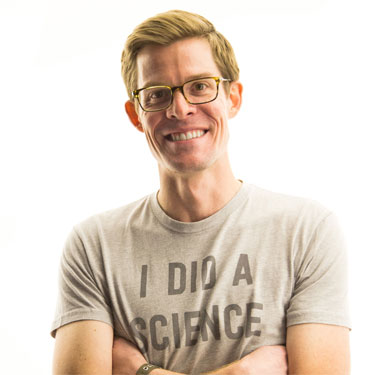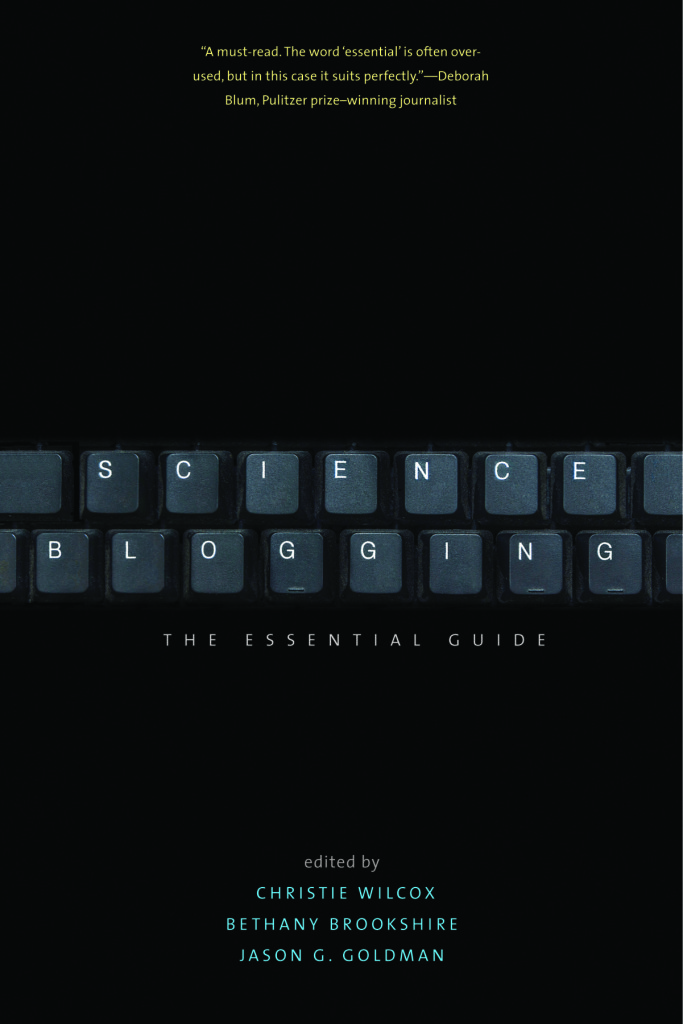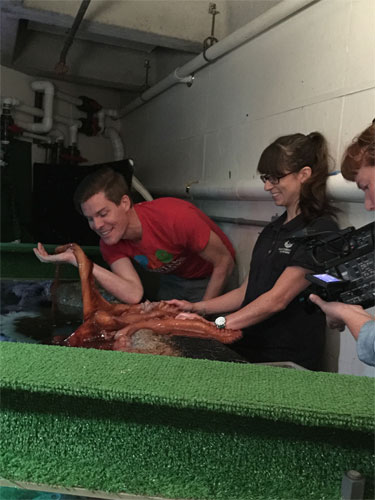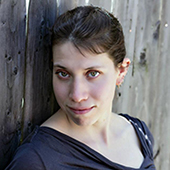
The Internet has changed many things about science writing, from its speed to its length. Science communication comes in audio, visual, webcomic, comic book, and GIF formats, just to name a few. And more and more, science communication involves video.
It might seem like anyone can make a video. Facebook Live means that all you need to do is hold a smartphone and start, and the audience will follow along. Many videos are very basic, with a single person looking into a camera and talking. But communicating tough science concepts requires more than just the words coming out of a talking head. It means script writing, editing, images, animation, and more.
Joe Hanson started out writing on the microblogging site Tumblr. Tumblr is a social microblogging site that relies heavily on embedded media such as images, GIFs, and video, with shorter chunks of text than one might see in a traditional blog or online article. Users like, comment on, and reblog Tumblr posts to their own streams, spreading a single piece of content far and wide, and often building on it themselves. He contributed a chapter about microblogging (very short posts with heavy reliance on images and other media) to the book Science Blogging: The Essential Guide.
Now, thanks to his PBS Digital Studios series It’s Okay to Be Smart, he’s one of the biggest names in the science-communication game on YouTube. Here, Hanson shares with Bethany Brookshire how he moved from Tumblr to YouTube, and what really goes into making a professional video product.
You have a PhD in biology and started out as a scientist. What made you decide to leave the bench and move into writing and video?
My early motivations were a mix of anxiety and terror. Midway through my PhD program, I saw this image of myself ten years in the future, hair beginning to gray, drinking gross room-temperature coffee, finishing my third postdoc and applying for my fourth, and it made me weep a little. It probably didn’t go exactly like that, but the writing on the job-market wall was pretty clear: “You should probably have a backup plan!”
Luckily, I’ve always loved talking about science, whether it was in the lab, in the classroom, or cornering people at parties (I’m great at parties). Science communication was a natural choice for me. At the time, I didn’t really know what that meant or how to turn it into a career, but I certainly didn’t let that get in my way.
This was back in the golden age of science blogs, when Twitter was fun and less dangerous. I discovered this incredible community of talented writers and science communicators, and basically devoured all of their work and advice. I started a science blog, it became popular beyond my wildest dreams, I started writing more than doing my research, and it was suddenly clear that staying in the lab had become my backup plan.
You started out as a writer, not in front of a camera. How did the transition to video happen?
I started out writing about science on Tumblr, which is … I don’t even know how to describe Tumblr, except that it is definitely not video.
My approach to science communication has always rested on humor, emotion, and storytelling. As my writing evolved, that meant connecting science to things like pop culture or history. It meant finding or inventing interesting characters. It meant breaking through the page and using illustrations and GIFs. It meant talking directly to the reader, and grabbing them by the feels. I just never realized this approach was setting me up to write videos, much less stand in front of a camera and host them.

My approach to science communication, and the audience I’d attracted, caught the attention of PBS Digital Studios, a branch of PBS that launched in 2012 with the mission of bringing PBS-quality programs and information to millennial audiences, which means “making awesome YouTube videos.” We decided to develop what I’d created with my blog into a video series.
Right after grad school, I did a fellowship at WIRED magazine, as part of the AAAS Mass Media Fellowship program. That’s where I cut my teeth at writing for mass audiences, and my editor was really cool about letting us experiment with multimedia storytelling. The moment I finished that fellowship, I moved into writing and video production full time thanks to the support of PBS.
It seems like everyone these days is uploading videos to YouTube, Facebook Live-ing, and making automatic GIFs. It can look like something that is easy and simple to do. From start to finish, what is involved in making one of your videos?
Making a video only means knowing how to press “record” and “upload.” That’s easy. Reading a list of 50 facts you found on Wikipedia isn’t that hard either, but that won’t nourish someone’s scientific understanding anymore than pure sugar will nourish their body. Making a good science video—one that people will watch and enjoy and (hopefully) learn something from—is much harder.
This year, we’ll actually be adding a few new writers—some really incredible ones—to the team, but up until now I’ve researched and written all 165+ episodes of It’s Okay to be Smart. At the core of every video I make there’s a lesson, so I tend to start with a good question. That question can be something academic, like “How does the olfactory system work?” Or it can be something more abstract, like “Is the existence of Bigfoot a falsifiable scientific concept?” If we’re not improving someone’s scientific toolkit, or equipping them with knowledge that will enrich their life, or making them stop and think about their place in the universe, we’re not doing enough.
Most of the script-writing process is research and preparation. I find writing the actual dialogue is really not that hard. The biggest challenges come in deciding how much to include or leave out and in crafting a story structure out of raw facts. One viewer may have watched every video we’ve ever put out, while another may be watching a science video for the first time. It’s a constant challenge to hit that point where something is as simple as possible, but not so simple that it’s dumbed down. Despite what 90 percent of television would have you believe, people don’t really like stories that treat them like they’re dumb! And keep in mind we only have five minutes or so to tell the story, so information efficiency is key. Online video is a different animal than just “a video.”

I write scripts kind of like a sculptor. I start with a big messy pile of raw information and research papers and scientific facts, and I carve things away until I’m left with just the right amount. I work with a director (Joe Nicolosi) and an editor/animator (Andrew Matthews) who are both visual-storytelling pros, but who aren’t scientists. So when I bring them a draft, I see if they can figure out what we’re looking at, and together we add the characters and the jokes and the skits and sketch out the visuals that will make the raw shape something nice to look at.
We shoot some videos on location in nature or with scientists, and some in front of a green screen. When you shoot in the real world, you get what you get (and nature doesn’t always cooperate) and we have to go back and write a clarification here, a transition here, or a deeper explanation there, not unlike traditional film/TV or radio production. Shooting on a green screen gives us total visual freedom where we can invent any universe we want, and this can really be an advantage when it comes to immersing someone in a science story.
Once we shoot, it goes to Andrew for editing and animation, and minus any technical illustrations that have to be just so, he really has total control there. We edit in Adobe Premiere and After Effects, and our illustrations come from stock libraries or are drawn by Andrew in Photoshop. The whole video-editing process takes about a week after we shoot. Andrew and Joe really are certifiable geniuses when it comes to visual storytelling and video editing. People often ask me how they can make things that look like what we make, and I don’t have the heart to tell them that what Andrew and Joe can do in a week usually takes like 4 or 5 people. I am lucky to work with such great people.
Then we post it on YouTube, tweet about it, and get on to making next week’s video!
What are some of the technical challenges with making and distributing video on the Internet now? What roles do Facebook and YouTube play in online science content?
Online video is such a crowded ecosystem. Even since 2013, when I started, there’s so many more talented creators making stuff, and audiences only have so much attention and time to split between them.

One thing many people still don’t realize is that YouTube, at its core, is a monstrously huge social network and search engine. Like other search engines and social networks, it relies on algorithms to serve up what it thinks people want. So we have the same challenges as any digital publisher or content creator: figuring out an algorithm that might as well be a black box, and convincing people to watch what we make when they have a dozen other choices asking them to click away.
Facebook has shaken up online video quite a bit, and I’m not sure anyone’s figured it out just yet. On one hand, Facebook video means we get our stuff freebooted (stolen and reuploaded) a lot more often, because compared to YouTube, Facebook has an abysmal record when it comes to protecting intellectual property. On the other hand, Facebook currently (and this might change any day) doesn’t have a way for creators to make money off of their videos, whereas YouTube feeds a portion of advertising revenue back to its creators. On a third, oddly mutant hand, the way people watch video on Facebook—usually with the sound off, reading text on screen, and typically not spending more than 10 to 30 seconds watching something—has forced creators to totally change the way they make videos, almost creating a rebirth of old silent movies. What works on YouTube doesn’t necessarily work on Facebook, and no one knows how this competition between such massive companies is going to play out. I can tell without hesitation that I like YouTube more, though.
How has your video series changed over time?
The technical aspects (lighting, graphics, editing) have gotten better obviously, just due to more experience. I hope that the writing and content has gotten better as well. The stories are richer, the ideas we approach are more complex, and they are packaged more densely and efficiently. All of this, it seems, has made them more valuable and entertaining. My jokes, unfortunately, have not gotten funnier.
The series has also gotten bigger in terms of impact. For any small team of creators, when a show you basically make out of your home offices ends up reaching millions of people a month, it’s kind of anxiety-inducing. But we think our success gives us great responsibility to do better work every week, and the privileged position given to us by our audience makes us want to tell even more important science stories.
How did you go about building an audience for It’s Okay to Be Smart?
For every hour I spend writing, researching, and creating, I spend at least half that time wrangling the various tentacles of social networking, managing our comments and community engagement, and reaching out to various websites and blogs to try and get our work featured.
Anyone who simply dumps their videos online will fail to build an audience. It takes a lot of legwork, although we do most of it sitting on our butts. This isn’t unique to online video, of course—it’s the reality of digital journalism across the board.
What kind of misconceptions do you think viewers might have about science-communication videos?
If there’s one misconception I could correct, it is that what we make looks different than what you see on TV or in documentaries because we want it to look different. It doesn’t look different because it is low quality or less sophisticated. It looks different because we are creating media for a new and different ecosystem and for an audience that wants their media to speak directly to them. Almost everything we do is deliberate, and is part of an ongoing experiment in a totally new genre of video storytelling. I wish more people would join us in that experiment!

Bethany Brookshire is an award-winning science writer at Science News and Society for Science & the Public. She runs the Scicurious blog and is the web producer and social-media manager for Science News for Students. She is one of three editors of Science Blogging: The Essential Guide (Yale University Press). She is also the guest editor of The Open Lab Anthology: The Best Science Writing Online, 2009. Bethany is based in Washington, DC. Find her at her website, or follow her on Twitter @scicurious.


